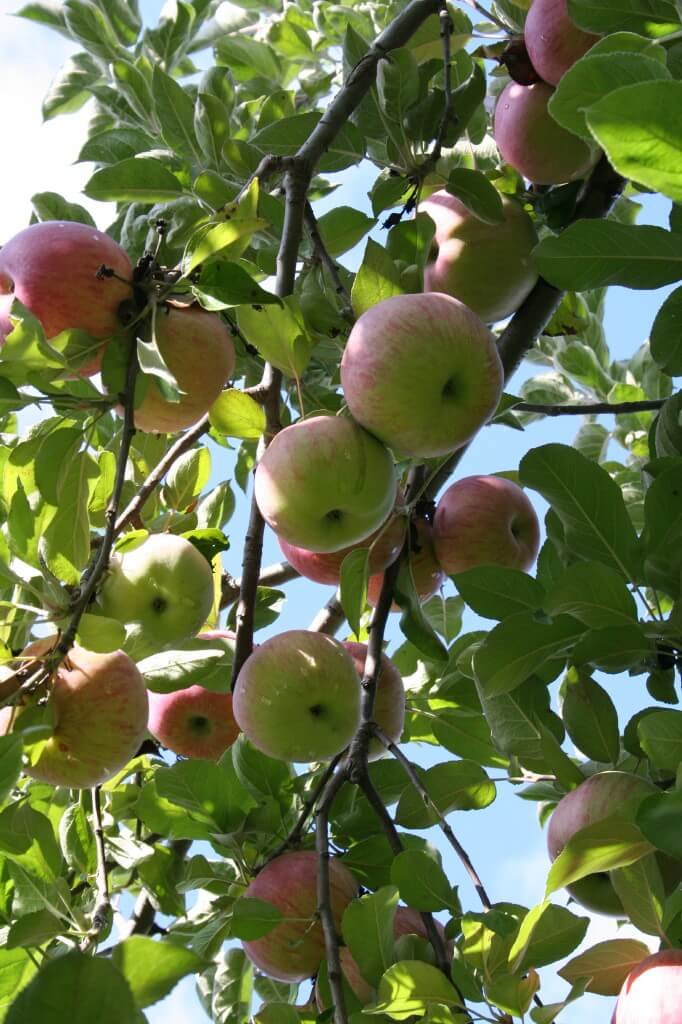Keep Your Fruit Trees Healthy While Protecting Wildlife
Photo credit © Hannah Tirrell-Wysocki
Have you ever observed the abundance of apples growing throughout Boulder? Perhaps you’ve noticed them in the fall — the deliciously sweet smell of ripe apples lingering in the air. Or maybe you had to carefully navigate around fallen fruit as you were walking through your neighborhood, local trails, or city sidewalks. There’s a reason why this surplus of fruit exists today.
Dating back to the 1880s, early settlers of Boulder Valley took up the age-old practice of agriculture, and much of north Boulder was developed as fruit orchards. The Bachelder Ranch, now known as Chautauqua Park, had a bountiful apple orchard, and areas like The People’s Crossing (formerly Settler’s Park) housed a variety of fruits, vegetables, and blossoming flowers. Today, many of the remaining fruit trees thrive in Boulder’s urban areas and wild lands; it’s not uncommon to find varieties of apple, peach, plum, apricot, and cherry trees growing in the area - though apples are the most common.
Unfortunately, many of these trees go by unnoticed and unmanaged. Once the fruit ripens, it falls to the ground and is left to rot on neighborhood sidewalks, on residents’ properties, and throughout our urban areas. While some of the trees are of beautiful heirloom varieties brimming with delectable fruit, others could benefit from pruning and other routine tree care to boost their health and quality of fruit. These tree tending practices also help to fight against fireblight, a contagious tree-borne disease that affects apples, pears, and other members of the family Rosaceae.
Photo credit © Blair Norman
We’re also losing these historic apple trees at an alarming rate due to age. Our colleagues at the Boulder Apple Tree Project share that we are losing roughly 10% of the 1,000 remaining apple trees left in the county. Not only are these trees an important piece of Boulder’s history, but they also serve as a necessary component of our ecosystem during this time of climate crisis and biodiversity loss. These trees grant us with food, serve as homes for a number of species, and provide shade and evaporative cooling as temperatures continue to rise each year.
Photo credit © Melanie Hill
In addition to the trees needing more care, the unharvested fruit serves as a dangerous attractant for wildlife. In 2014 when Community Fruit Rescue was founded, Boulder had a bumper crop year, and massive amounts of fruit were falling from trees and rotting on the ground. The amount of available urban fruit going to waste was astounding, but also served as an easy meal for black bears. In the fall, bears require roughly 20,000 calories per day to prepare for winter hibernation. As a result, they tend to look for the lowest effort ways to consume the highest number of calories. Boulder’s urban abundance of fruit proved to be an easy meal that drew these opportunists into town - and urban areas are very dangerous places for a black bear to spend time. Bears who become habituated to city life risk being euthanized, hit by cars, poisoned by eating garbage, and more. Because of Boulder’s close proximity to the mountains, bears and other wildlife will always come into town. It’s our job to ensure they don’t get too comfortable.
Owning fruit trees in Boulder comes with a responsibility - both for the tree itself, and for our local wildlife. But we have great news: Community Fruit Rescue is here to help Boulderites keep their fruit trees healthy, fight against food insecurity, protect black bears, and build a resilient community with a thriving natural environment.
Here are a few ways you can help us take action:
Fruit Tree Care
Photo credit © Amarnath
We’ve compiled a list of resources to show you what exactly your fruit tree needs to thrive. Start with pruning in the late winter/early spring, followed by mulching to insulate your tree’s root system, you’ll then move into fertilizing in the spring, and fruit thinning and trunk banding in May/June to protect against potential pests. And don’t forget to clean up any fallen fruit to discourage larval development and protect the larger shared fruit tree canopy. View all fruit tree care resources here, and check our Events page to learn about our Fruit Tree Care Workshops.
Harvest With Us
In 2022, Community Fruit Rescue volunteers harvested nearly 23,000 lbs of fruit from 134 residential sites in Boulder. Instead of leaving the fruit to rot on the ground, we were able to distribute it to food insecure individuals and families through our partners at Community Food Share, as well as our volunteer pickers, and even to local farm animals and the rescued bears at the Wild Animal Sanctuary. We’d love to have you join us for a harvest this season—you can even take some of the bounty home with you! Volunteer with us.
Sign Up for Harvest Assistance
If you’re a tree owner and in need of harvest assistance, register your fruit tree(s) with us and our harvest leaders and volunteers will help you get the fruit gleaned when it’s ripe. Sign up for harvest assistance.
Photo credit © Hannah Tirrell-Wysocki
Photo credit © Community Fruit Rescue
Protect Our Wildlife
If you live in Boulder, you already know that we share the land with a number of wild species. Living in western Boulder especially brings on a certain responsibility, as this region is the gateway into the city for wildlife like black bears and mountain lions. Become a steward of our natural environment by taking a few simple steps that will help protect our wild neighbors.
Harvest your fruit in a timely manner to prevent bears from coming to your property. If you need assistance harvesting your trees, reach out to our team.
Remove bird feeders (hummingbird feeders, too!) during March-November when bears are active. Consider planting native pollinator gardens to attract birds and insects instead.
Properly secure your trash and compost in fully latched bear-resistant canisters.
Install electric fencing for beehives and small livestock such as chickens and goats.
Haze wildlife away from a safe distance to prevent habituation. Use loud sounds (banging pots and pans, whistling, clapping) and shine bright lights to scare them away from your property. Remember, urban areas are dangerous places for wildlife like black bears and mountain lions!
Read up on how to safely live with urban wildlife: the City of Boulder and Colorado Parks & Wildlife have some amazing resources.
Photo credit © Melanie Hill







